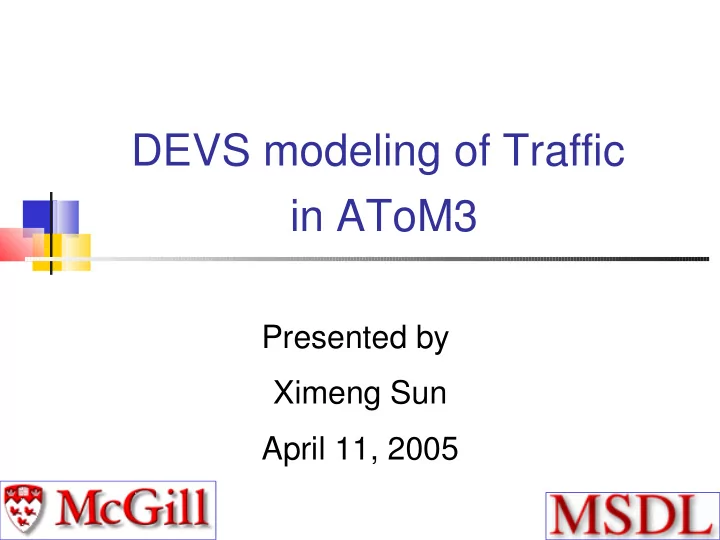

DEVS modeling of Traffic in AToM3 Presented by Ximeng Sun April 11, 2005
References [1] Bernard P. Zeigler, Herbert Praehofer, and Tag Gon Kim. Theory of Modeling and Simulation. Academic Press, 2000. [2] Hans Vangheluwe, Juan de Lara. Computer Automated Multi-Paradigm Modelling for Analysis and Design of Traffic Networks. Proceedings of the 2004 Winter Simulation Conference. [3] Ernesto Posse and Jean-Sebastien Bolduc. Generation of DEVS Modeling and Simulation Environments. Proceedings of the 2003 Summer Simulation MultiConference, 2003 [4] Modelling, Simulation and Design Lab. AToM3 V0.3: A Tool for Multi-formalism and Meta-Modelling http://msdl.cs.mcgill.ca/MSDL/research/ [5] Bernard P. Zeigler, Hessam S. Sarjoughian. Introduction to DEVS Modeling and Simulation with JAVA. http://www.acims.arizona.edu/SOFTWARE/software.shtml#DEVSJAVA
Outline Introduction TimedTraffic Formalism DEVS Formalism Map TimedTraffic to DEVS Meta-Modeling TimedTraffic Meta-Model DEVS Meta-model Model Transformation Code Generation (Python and Java) Demo Conclusion
Introduction TimedTraffic Formalism DEVS Formalism Map TimedTraffic to DEVS Meta-Modeling TimedTraffic Meta-Model DEVS Meta-model Model Transformation Code Generation Demo Conclusion
TimedTraffic Formalism Based on models described in [2].
DEVS Formalism
Introduction TimedTraffic Formalism DEVS Formalism Map TimedTraffic to DEVS Meta-Modeling TimedTraffic Meta-Model DEVS Meta-model Model Transformation Code Generation Demo Conclusion
TimedTraffic Meta-Model Based on the meta-model described in [2].
DEVS Meta-Model Based on the meta-model described in [3] and the work done by Denis Dube (http://moncs.cs.mcgill.ca/people/hv/teaching/MSBDesign/presentations/050324.DenisDube.pdf) .
TimedTraffic to DEVS Transformation Rules AToM3 can automatically generate nice documents for all transformation rules.
Rule 0: Initialization
Rule 1: Generate Top-level “Traffic” Coupled DEVS
Rule 2: Transform “Source” to “Generator” Atomic DEVS
Rule 3: Transform “Sink” to “Collector” Atomic DEVS
Rule 4: Transform “RoadSection” to “Road” Atomic DEVS
Rule 5: Connect “Generator” with “Road”
Rule 6: Connect “Road” to “Collector”
Rule 7: Transform “FlowTo” to “Channel”
Rule 8: Copy “Capacity” information into “Road”
Rule 9: Remove “Capacity”
Rule 10: Transform “TrafficLight” to “TrafficLight” Atomic DEVS (double)
Rule 11: Transform “SyncWith” relation
Rule 12: Transform “TrafficLight” to “TrafficLight” Atomic DEVS (single)
Rule 13: Connect “TrafficLight” with “Road”
Rule 14: Remove “TrafficLight” (step 1)
Rule 15: Remove “TrafficLight” (step 2)
Rule 16: Remove “RoadSection” (step 1)
Rule 17: Remove “RoadSection” (step 2)
Rule 18: Connect “Road” Atomic DEVS with “Traffic” Coupled DEVS
Rule 19: Connect “TrafficLight” Atomic DEVS with “Traffic” Coupled DEVS
Rule 20: Connect “Generator” and “Collector” Atomic DEVS with “Traffic” Coupled DEVS
Code Generation Simulator in Python (PythonDEVS) (Based on the work described in [3].) Write codes to specify initial parameters, time advance function, output function, and conditions for transitions Click “Gen” button in DEVS meta-model toolbar to generate simulators in Python There will be three files at top level: DEVS.py, Simulator.py, Traffic.py For each atomic model there will one sub-directory which contains one file, such as University_Street.py Run simulation e.g., $ python Traffic.py 10000 Simulator in Java (DEVSJAVA)
initParams internal transition time advance external transition output function
Introduction TimedTraffic Formalism DEVS Formalism Map TimedTraffic to DEVS Meta-Modeling TimedTraffic Meta-Model DEVS Meta-model Model Transformation Code Generation Demo Conclusion
DEVSJAVA Class hierarchy of DEVS classes
Conclusion AToM3 is an amazing tool! Pure graphical translation from DEVS or other formalism to a real programming language such as Python or Java? Using neutral language to describe specific cases in transformation rules?
Thank you!
Recommend
More recommend